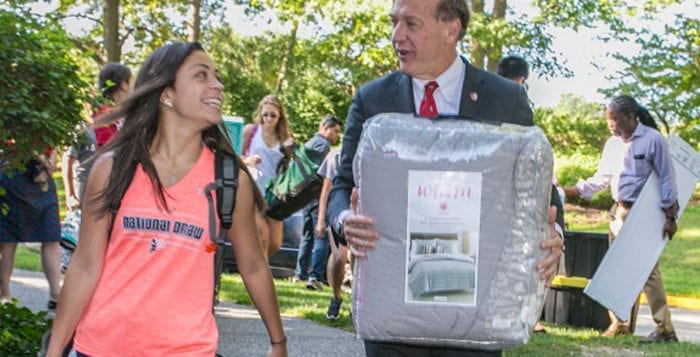By Rita J. Egan
Stony Brook University has been doing its part to make campus life feel more like home for most students, by offering gender-inclusive housing.
For a decade, the option has allowed students to share a room with friends or siblings no matter what their gender, or choose housing based on the gender they identify with. The only requirements are that students have to be 18 or older and sign a contract stating they will respect everyone in their residence hall.
On Aug. 25, move-in day for freshmen and transfer students, resident assistant Derrick Wegner, who is transgender, was on hand to greet newcomers. The senior psychology major said he was happy to have the option when he came to Stony Brook. Wegner, who lives in Wurtsboro, said college is a great opportunity for a fresh start, especially for young people looking to transition.

Wegner said the gender-inclusive housing option at Stony Brook creates a happy and safe environment, and he feels being happy and healthy plays a big part in being a successful student.
“You’re of value, and you belong here,” he said.
This year the senior is thrilled to be sharing a dorm with his best friend Sydney Monroe Gaglio, who he met early on in college through mutual friends.
“She’s my best friend, and I’m her best friend,” he said. “Just having somebody that I know I can go home to, and [say] this happened, and she’s like ‘I’m sorry.’ She just gets it.”
Ian Rose, who majors in engineering chemistry and applied mathematics and statistics, was thrilled when he heard of the gender-inclusive option. The junior said last year he made friends with Daniel Mahoney, Brandon O’Rourke, Bianca Mugone and Brittany Voboril, and they all became great friends. They lived in the same residence hall — the males in one room on one floor and the girls in their own room on another floor. Many nights last year they would find themselves in each other’s rooms studying or talking and decided to live together.
“We’re friends just hanging out,” Rose said.
This academic year the five are living in a suite with three bedrooms and one bathroom. Rose said at first his only concern was how things would work out in the bathroom, but so far things are going smoothly.
“I just want this to show everyone that guys and girls living together isn’t weird or uncomfortable,” Rose said. “You’re living with your friends; friends are friends. It doesn’t matter if you’re a boy or girl or different skin tone. It doesn’t matter; we’re all the same.”

Catherine-Mary Rivera, director of residential programs at SBU, said the program began as a small pilot initiative at the university 10 years ago, and grew slowly through the years. In 2016, approximately 40 students took advantage of the housing option, while this year more than 200 students — out of 10,683 living on campus — chose gender-inclusive residences across the campus.
She said the university wants to ensure that all students feel safe and welcome because it’s their home, and they have received plenty of positive feedback regarding the housing.
“The fact that it has grown from 42 to 200 has shown us students feel that they have a place here, and that they don’t have to either feel not comfortable being themselves or feel that Stony Brook doesn’t have a place for them, or they have to remain quiet about who they are or how they express themselves,” Rivera said. “That freedom has come through very clearly that this is a place they can thrive and be their true selves and live with their friends.”
The housing option also allows couples to live together; however, the university does recommend romantic partners think twice before making that decision.
“We want you to branch out and build a stronger community and have healthy relationships, and it may not be best to live with your significant other at this point,” Rivera said.
In addition to gender-inclusive housing, she said SBU offers all-gender, multi-stall bathrooms throughout campus and on the main floors of residence halls, in addition to all-men and all-women restrooms. Software updates have also been made to the school’s system allowing students and faculty members to choose their preferred names and pronoun if they would prefer to be addressed by something other than their legal name. The change means that identification cards and email addresses now show the name a person uses on a regular basis instead of their legal name.





